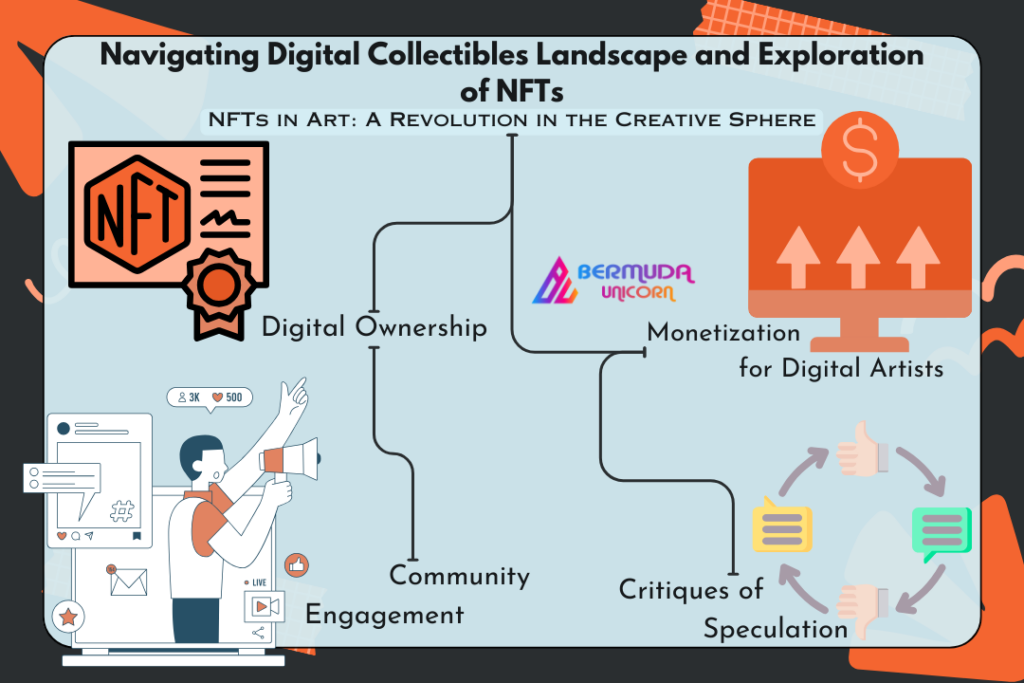![]()

In recent years, the world of NFT collectibles has undergone a seismic shift, with Non-Fungible Tokens (NFTs) emerging as a disruptive force in the art, gaming, and entertainment industries. These blockchain-based tokens have transformed the way we perceive and trade collectibles, ushering in a new era of digital ownership. In this blog, we’ll embark on a journey through the NFT frontier, exploring what NFTs are, their impact on various sectors, and how to navigate this exciting digital landscape.
Understanding NFTs: Beyond the Hype
Non-fungible tokens, or NFTs, are unique digital assets that represent ownership or proof of authenticity of a specific item, piece of art, video, or any other digital or physical object. Unlike cryptocurrencies such as Bitcoin or Ethereum, which are interchangeable and have equal value, NFTs are one-of-a-kind, making them ideal for representing ownership of rare or unique items.
NFTs derive their uniqueness from blockchain technology, which ensures transparency, security, and immutability. Each NFT has a unique identifier, often linked to a smart contract on a blockchain like Ethereum, verifying its authenticity and provenance.
NFTs in Art: A Revolution in the Creative Sphere
One of the most visible and transformative applications of NFTs has been in the world of art. Traditional artists and digital creators alike are embracing NFTs as a means to monetize their work, gain control over distribution, and connect directly with their audience.

Through NFTs, artists can sell their digital creations as unique tokens, giving collectors proof of ownership. This has enabled artists to receive royalties every time their NFT is resold, fostering a more sustainable income model for creators. Notable examples include the $69 million sale of Beeple’s “Every Day: The First 5000 Days” and the explosion of digital art marketplaces like “Bermuda Unicorn“.
Gaming and NFTs: Enhancing Player Experiences
The gaming industry is another sector that has fully embraced NFTs. Game developers are using NFTs to create in-game assets that players can buy, sell, and trade outside the game environment. This has added a new layer of ownership and value to virtual items, making gaming more immersive and potentially profitable.
NFTs can also foster a sense of scarcity and uniqueness in games, with rare in-game items becoming sought-after collector’s items. Games like “Axie Infinity” have turned NFT-based assets into a livelihood for players, allowing them to earn real income by participating in the game’s economy.
Navigating the NFT Landscape
As you set out to navigate the NFT frontier, here are some key considerations to keep in mind:
1. Research and Due Diligence
Before diving into the world of NFTs, it’s crucial to conduct thorough research. Understand the underlying blockchain technology, the specific NFT marketplace you want to use, and the artists or projects you’re interested in. Beware of scams and frauds, as the decentralized nature of NFTs can make it harder to recover lost assets.
2. Wallet and Security
To participate in the NFT ecosystem, you’ll need a digital wallet that supports the blockchain where your chosen NFTs reside (usually Ethereum). Ensure that your wallet is secure and well-protected, as it will hold your valuable digital assets.

3. Diversification
It is advisable to refrain from consolidating all of your digital assets in a single repository. Diversify your NFT portfolio just as you would with traditional investments. This can help mitigate risks and increase the chances of finding valuable assets.
4. Long-Term Perspective
While some NFTs may experience rapid price fluctuations, it’s essential to approach the NFT market with a long-term perspective. Collect what you love and believe in the value of the NFT, rather than solely chasing short-term gains.
5. Environmental Impact
Be aware of the environmental impact of NFTs, as blockchain networks like Ethereum require significant energy consumption. Consider supporting NFT projects that are committed to eco-friendly solutions or those built on more energy-efficient blockchains.
Conclusion
The rise of NFTs has transformed the digital collectibles landscape, offering exciting opportunities for artists, creators, gamers, and investors. As you navigate this frontier, remember to stay informed, exercise caution, and approach NFTs with a thoughtful, long-term perspective. By doing so, you can not only participate in the NFT revolution but also contribute to its responsible and sustainable growth in the digital age.
Frequently Asked Questions (FAQs)
1: What is an NFT?
An NFT, or Non-Fungible Token, is a unique digital asset that represents ownership or authenticity of a specific item, artwork, or collectible using blockchain technology.
2: How do I buy an NFT?
To buy an NFT, you need a digital wallet compatible with the blockchain (e.g., Ethereum), where the NFT is hosted. Then, you can visit NFT marketplaces like OpenSea, browse, and make a purchase using cryptocurrency.
3: Can I sell my NFT after buying it?
Yes, you can sell your NFT on NFT marketplaces. Most NFTs can be resold, and creators often receive a percentage of the resale price as royalties.
4: Are NFTs environmentally friendly?
NFTs have faced criticism for their environmental impact, mainly when hosted on energy-intensive blockchains like Ethereum. However, some NFT projects are exploring greener alternatives on eco-friendly blockchains to mitigate this concern.
